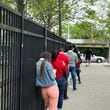The next few days will determine whether UPS puts to rest the ghost of Christmas past.
Today is forecast to be the delivery giant’s busiest on record. And after a year of intense preparation and planning, it kicks off the final push in UPS’s effort to atone for faltering during last year’s last-minute rush.
The Sandy Springs-based company isn’t ready to declare mission accomplished, but “things are going smoothly,” UPS spokesman Andy McGowan said late last week. “We’re on plan.”
A year ago, UPS fumbled amid a pile-up of millions of packages, delivering some packages too late for Christmas. That prompted complaints and bad publicity that threatened its service reputation.
Lithonia resident Taqueesa Davis received UPS packages after Christmas last year, and she said it’s changed the way she shops.
“It actually made me more hesitant with buying online,” Davis said. This year, “we decided not to even order online for our Christmas gifts. We went into the store.”
Competitor FedEx faced some complaints about late deliveries as well, but UPS bore the brunt of the hit last year.
UPS’s plan included boosting its temporary workforce for the holidays to 95,000, including 1,900 workers in metro Atlanta, and is renting additional delivery vehicles such as U-Hauls.
The company said it is spending $500 million to prepare for the holiday shipping season and expand operations going forward. That includes a new “mobile distribution center village” in Roswell, a series of connected modular units where UPS brown trucks can pull up.
UPS can’t control every factor, though. Success will depend not only on the accuracy of its own forecast and execution of its own plans, but also on shopper procrastination, retailers’ 11th-hour promotions and, amid it all, a labor slowdown at West Coast ports handling goods coming in from Asia.
FedEx has also geared up, hiring more than 50,000 seasonal workers, up from 40,000 last year.
“We go through all year to plan for this month. This is what we call our Super Bowl,” said Frank West, an operations manager for the FedEx Express facility in Marietta.
During the holidays, FedEx heavily uses what it calls a “floating warehouse” in Buckhead — essentially a trailer for drivers on Buckhead routes to pull up to and unload their packages. The packages are sorted in the trailer and then shuttled to Hartsfield-Jackson to be flown off to Memphis or another FedEx hub.
“This time of year, everybody’s volume goes up,” said Michael Miles, a spokesman for the U.S. Postal Service in Atlanta. The Postal Service expects package volume to be up about 12 percent this holiday season.
UPS, FedEx and the U.S. Postal Service have all seen continued growth in e-commerce, driving an even bigger need to prepare for ever-increasing volumes of packages. A recent National Retail Federation survey showed nearly half of holiday shoppers planned to shop online.
Satish Jindel, president of shipment technology firm ShipMatrix Inc., said his data shows UPS had on-time delivery performance of 95 percent for express and ground service in the second week of December, up from 92 percent last year. FedEx also showed improvement.
Jindel said labor issues at West Coast ports have delayed products from overseas, while shoppers already have less time for shopping due to the late date of Thanksgiving. As a result, “volumes are going to pick up at even a higher rate than even they were planning for,” Jindel said.
UPS said it has had some of its retail customers’ inventories have been affected by the dock worker labor issues, adding that it is “collaborating with customers to address problems.”
Still, Jindel thinks delivery delays may not be as bad as they were last year, when bad weather also factored in.
With all of the potential pitfalls, UPS, FedEx and retailers had been pushing for customers to place their online orders earlier, noting they could avoid higher-priced last-minute shipping. The National Retail Federation’s survey showed the average holiday shopper finished 52.9 percent of their shopping by Dec. 10, up from 49.9 percent last year.
“But if the customer wants to procrastinate,” Jindel noted, “the retailer has no ability to limit their ability to do so.”






